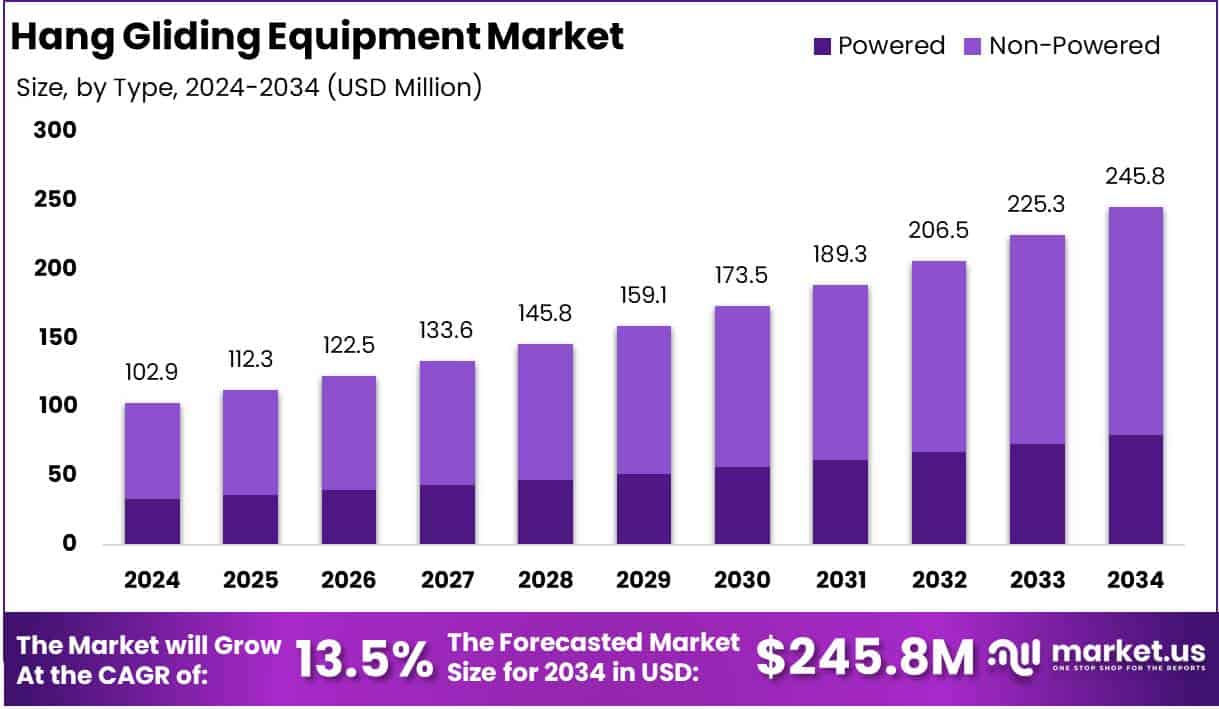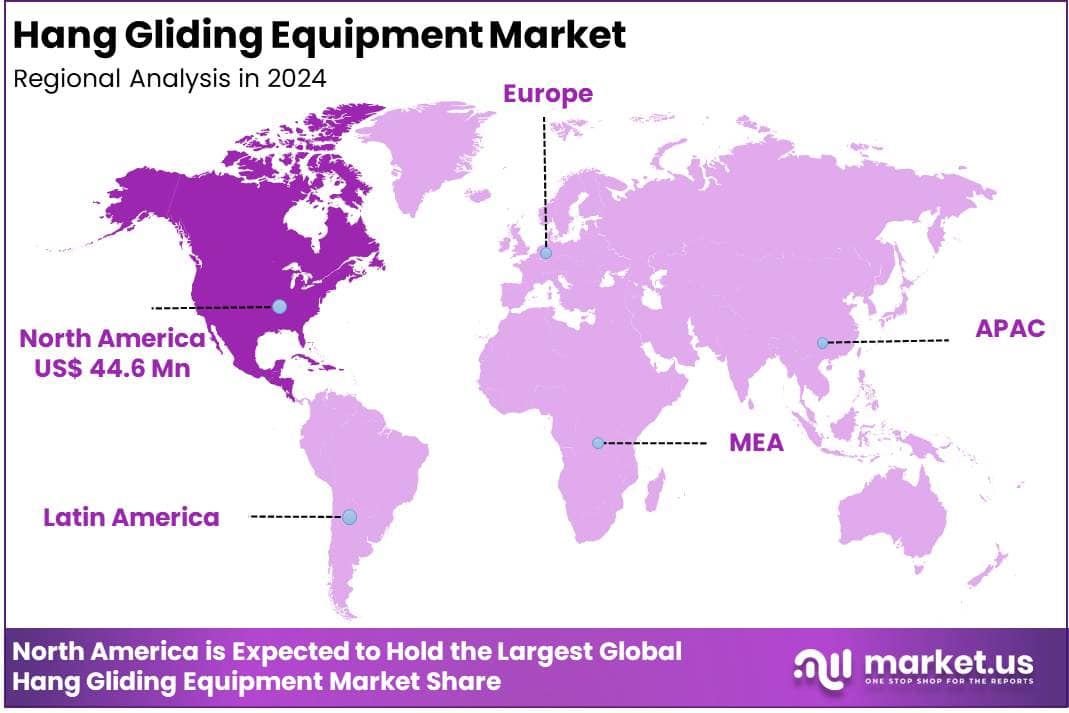Table of Contents
Introduction
The Global Hang Gliding Equipment Market is projected to reach approximately USD 245.8 million by 2034, up from USD 102.9 million in 2024, exhibiting a compound annual growth rate (CAGR) of 9.1% during the forecast period from 2025 to 2034.
The hang gliding equipment market encompasses the production, distribution, and sales of essential gear used in the sport of hang gliding, including gliders, harnesses, helmets, reserve parachutes, and variometers. Hang gliding equipment is designed to provide aerodynamic efficiency, safety, and control for pilots engaging in this form of air sports.
The market is driven by several growth factors, including rising adventure tourism, increasing participation in aerial sports, and advancements in lightweight and durable materials enhancing equipment performance and safety. Additionally, technological innovations, such as GPS-enabled variometers and improved aerodynamics in glider designs, are expanding the market’s appeal to both professionals and recreational enthusiasts.
Demand for hang gliding equipment is also influenced by growing interest in extreme sports, particularly among millennials and adventure seekers looking for unique outdoor experiences. Furthermore, government initiatives promoting tourism and outdoor sports activities, coupled with favorable weather conditions in specific regions, contribute to market expansion.
However, the market faces challenges such as regulatory restrictions, high costs associated with advanced hang gliding gear, and safety concerns that may limit mass adoption. Despite these constraints, significant opportunities exist, particularly in emerging economies where adventure tourism is gaining momentum. The rising popularity of customized and lightweight equipment tailored for different skill levels presents additional market potential.
Moreover, digital marketing and online retail channels are enhancing accessibility, allowing manufacturers to reach a broader consumer base. Overall, the hang gliding equipment market is poised for steady growth, driven by increasing participation in air sports and ongoing technological advancements improving safety and performance.

Key Takeaways
- The global hang gliding equipment market is expected to expand from USD 102.9 million in 2024 to USD 245.8 million by 2034, registering a CAGR of 9.1%.
- Non-powered hang gliding equipment leads the market, accounting for 67.5% of the share in 2024.
- Gliders dominate the product type segment with a 53.2% market share in 2024, underscoring their essential role in the sport.
- Recreational hang gliding equipment holds the largest share at 72.2% in 2024, reflecting high consumer demand.
- Offline distribution channels account for 63.3% of the market in 2024, highlighting the importance of in-person purchasing.
- North America captures 43.4% of the market share in 2024, valued at approximately USD 44.6 million.
Hang Gliding Equipment Statistics
- Hang gliding attracts over 25,000 Americans annually.
- The global extreme sports market is worth $200 million, with 490 million participants worldwide.
- Safety is critical. Equipment checks and pre-flight inspections reduce risks.
- Hang gliding reports an average of 3.5 deaths per year.
- Starting a hang gliding business costs over $50,000. This includes equipment, training, and permits.
- Trained instructors and strict safety measures improve security.
- The mortality rate is 1 in 560 flights.
- In 1974, 40 hang gliding fatalities occurred annually.
- Thermals can lift pilots up to 20,000 feet.
Emerging Trends
- Increasing Interest in Adventure Sports: The global surge in adventure tourism has led to a heightened interest in activities like hang gliding, contributing to the growth of the hang gliding equipment market.
- Technological Advancements: Innovations in materials and design have resulted in lighter, stronger, and more aerodynamic hang gliders, enhancing both safety and performance.
- Rising Popularity of Extreme Sports: The extreme adrenaline sports industry, which includes hang gliding, attracts over 490 million participants worldwide, generating approximately $200 million in revenue annually.
- Growth of Adventure Tourism: The increasing trend of adventure tourism and experiential travel has significantly boosted demand for hang gliding experiences, thereby driving the market for related equipment.
- Development of Training Programs: The expansion of hang gliding training and certification programs has made the sport more accessible, encouraging new participants and supporting market growth.
Top Use Cases
- Recreational Flying: Individuals engage in hang gliding as a leisure activity, enjoying the experience of unpowered flight and scenic views.
- Adventure Tourism: Tour operators incorporate hang gliding into adventure packages, attracting thrill-seekers and contributing to local tourism economies.
- Competitive Sports: Hang gliding competitions test pilots’ skills in navigation, duration, and distance, fostering a community of enthusiasts and professionals.
- Aerial Photography: Hang gliders equipped with cameras are used for capturing unique aerial photographs and videos, serving both artistic and commercial purposes.
- Environmental Monitoring: Researchers utilize hang gliders to conduct environmental surveys and monitor wildlife in hard-to-reach areas, offering a low-impact alternative to motorized aircraft.
Major Challenges
- Perception of Safety Risks: Despite advancements in safety, hang gliding is often perceived as dangerous, which can deter potential participants.
- High Initial Investment: The cost of equipment and training, ranging from $3,000 to $5,000, poses a significant barrier to entry for many individuals.
- Aging Participant Demographics: The core population of hang gliding enthusiasts is aging, leading to a decline in participation rates over recent years.
- Regulatory Hurdles: Varying regulations across regions can complicate the operation of hang gliding businesses, affecting market growth.
- Environmental Concerns: The need for suitable flying sites may raise environmental issues, leading to restrictions that impact the availability of locations for hang gliding activities.
Top Opportunities
- Emerging Markets: Regions such as Asia and Africa present growth opportunities due to increasing interest in adventure sports and developing tourism infrastructure.
- E-commerce Expansion: The rise of online retail platforms allows manufacturers to reach a broader customer base, facilitating easier access to equipment.
- Eco-Friendly Equipment: Developing hang gliding equipment using sustainable materials can attract environmentally conscious consumers and differentiate brands in the market.
- Collaborations with Tourism Operators: Partnering with adventure tourism companies can promote hang gliding experiences, increasing equipment demand.
- Enhanced Training Programs: Offering comprehensive training and certification programs can attract new participants, fostering market growth.
Key Player Analysis
The Global Hang Gliding Equipment Market in 2024 is characterized by a competitive landscape where key players are focusing on innovation, safety enhancements, and lightweight materials to drive market growth.
Aeros Company and Airborne Windsports Pty Ltd are at the forefront, leveraging advanced aerodynamic designs and durable composite materials to enhance performance and safety. Albatross Flying Systems Pvt. Ltd. is expanding its footprint by catering to emerging markets and integrating technological advancements into its glider designs.
Apco Aviation and ICARO 2000 remain strong competitors, with a focus on high-quality harnesses and flight accessories that enhance the overall gliding experience. Finsterwalder GmbH and Flight Design contribute to the industry through innovative structural improvements, emphasizing lightweight frames and reinforced wing designs.
Kortel Design and La Mouette specialize in ergonomic harnesses and safety gear, ensuring pilots benefit from comfort and enhanced in-flight control.
Among manufacturers, Moyes Delta Gliders and North Wing continue to be dominant forces in the market, known for their high-performance gliders that cater to both recreational and competitive pilots. Stilescom and Wills Wings Inc. maintain their strong market presence by offering a balance of affordability and performance, making hang gliding more accessible to a broader consumer base.
Overall, the competitive landscape is driven by product differentiation, material innovation, and technological advancements. Market leaders are expected to focus on expanding their global distribution networks while investing in research and development to improve aerodynamics, safety, and user experience in hang gliding equipment.
Top Key Players in the Market
- Aeros Company
- Airborne Windsports Pty Ltd
- Albatross Flying Systems Pvt. Ltd.
- Apco Aviation
- Finsterwalder GmbH
- Flight Design
- ICARO 2000
- Kortel Design
- La Mouelle
- Moyes Delta Gliders
- North Wing
- Stilescom
- Wills Wings Inc.
Regional Analysis
North America Leads Hang Gliding Equipment Market with Largest Market Share of 43.4%
North America dominates the global hang gliding equipment market, accounting for 43.4% of the total market share in 2024, with a market valuation of approximately USD 44.6 million. The region’s leadership is driven by a strong adventure sports culture, well-established infrastructure for aerial sports, and increasing participation in recreational activities. The United States remains a key contributor, with a high concentration of hang gliding clubs, training centers, and favorable regulatory support for outdoor sports.
Additionally, rising disposable income and the growing preference for extreme sports contribute to market expansion. The presence of leading equipment manufacturers and frequent advancements in safety and material technologies further solidify North America’s position as the dominant region in the hang gliding equipment market.

Recent Developments
- In 2024, Diamondback Energy, Inc. (NASDAQ: FANG) completed its merger with Endeavor Energy Resources, L.P., marking a significant milestone in the company’s growth. This merger strengthens Diamondback’s position as a leading independent oil producer in North America. With a premier asset base in the Permian Basin, the company is well-positioned to drive strong cash flow and operational efficiency. CEO Travis Stice emphasized that the combination not only expands Diamondback’s scale but enhances its ability to deliver value through high-quality inventory and disciplined execution.
- In 2023, North Wing successfully finalized flight testing and introduced a refined, cost-effective wing option for the ATF Soaring Trike, the Discovery 207. Built for performance and reliability, the ATF Soaring Trike features a lightweight, durable frame and the high-efficiency Solairus Wing. A new electric propulsion system is now available, offering a 21kW, 28HP engine with zero emissions and near-silent operation. Pilots can experience improved glide performance with the optional Folding Propeller. Existing ATF owners can upgrade their trikes with the ATF Retrofit Kit, bringing electric-powered flight within reach.
Conclusion
The global hang gliding equipment market is poised for substantial growth, driven by increasing adventure tourism, technological advancements, and rising participation in aerial sports. Despite challenges such as safety concerns, regulatory hurdles, and high initial costs, opportunities in emerging markets, eco-friendly innovations, and e-commerce expansion provide a strong growth outlook. North America leads the market, while key players focus on innovation and safety enhancements to meet evolving consumer demands. With continuous advancements in materials and design, the hang gliding equipment market is expected to witness steady expansion in the coming years.
Discuss Your Needs With Our Analyst
Please share your requirements with more details so our analyst can check if they can solve your problem(s)





